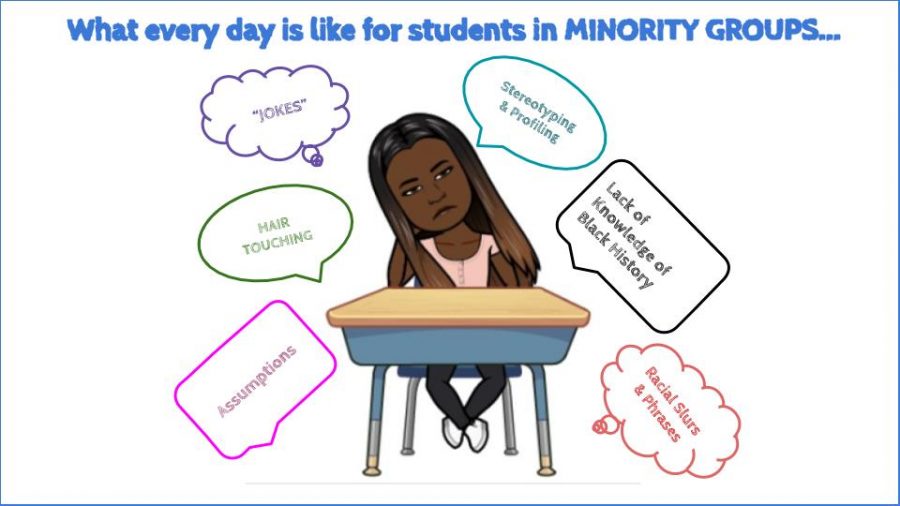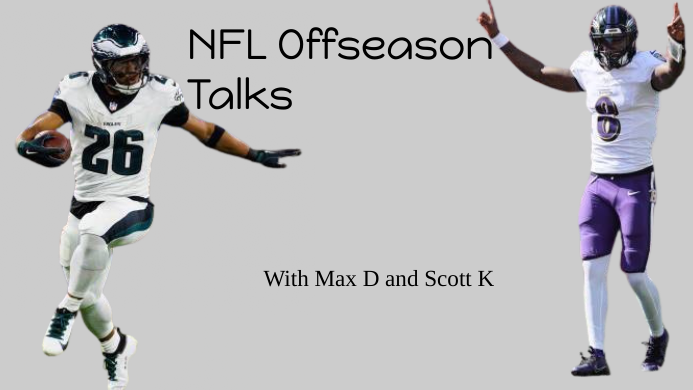Still I Rise: African American Culture Club teaches lessons about racism to staff
“Any one experience of racism is one experience too many.” –Beth Ericsson, science teacher.
Minority students at LHS explained that they deal with these negative experiences on a daily basis.
May 11, 2020
**This is Part I of a series of stories featuring the African American experience in a suburban Maryland high school.
As African American students in a predominantly Caucasian school, there are multitude of inherent differences from peers. The primary tensions and adversities arise from skin color and cultural experiences. The staff wants to be sensitive and help, but they are not always aware of what goes on every day among different groups.
During a recent faculty meeting, ten students who are members of AACC (African American Culture Club) presented their stories to the staff and administration. During the presentation, the minority students covered topics including racial slurs, stereotypes, and interpersonal dilemmas that they face in the halls and classrooms, from peers, and, more surprising, at times from teachers.
The idea for this presentation originated during a club meeting when students were creating posters for Black History Month. The students were discussing how some of the Black and LatinX students feel as though they don’t belong.
Club advisor Beth Ericsson said, “I asked myself, ‘What can I do about this?’ I knew we had to start by informing the teachers and administration, so we can be more aware of our own words and actions as well as the words and actions of our student body, in order to address this issue.”
“Anger and sorrow dominated my emotions,” said Ericsson. “ I know from 15+ years of experience at Linganore that the majority of our Linganore family is not racist. However, any one experience of racism is one experience too many.”
Immediately after hearing Ericsson’s idea, the administration was supportive.
At the start of the presentation, the AACC students asked four questions, including “Name two inventions brought to us by black people” and “What is an HBCU?” In addition, the students discussed, very openly, the differences in the connotation of the use of the N-word.
The mostly silent staff members answered the “inventions” question with the classic George Washington Carver and peanuts. They realized immediately that there is a big problem.
Kojo Benefo, AACC’s Vice President, who led the quiz emphasized that the teachers’ awareness of the problem, “was a [first] stride towards a better Linganore Community.”
“It’s not easy as a minority group to speak our voices, especially when we thought we didn’t want to be heard,” said Benefo.
Randi Kirkland, English teacher, reflected on the meeting. “My reaction to the Diversity Club’s presentation was one of sadness AND inspiration. I was heartbroken when LHS students stood, in front of a room full of people whose jobs it is to make them realize their full potential, confessing they are being treated less than what they deserve.”
Throughout the meeting, the presentation consisted of a slideshow where topics of inappropriate hair touching, muttered and racist unkindness in the cafeteria and other behaviors that teachers don’t always notice were discussed.
Along with these slides, every member had the opportunity to share an upsetting personal story or experience that had occurred during the school day, either with students or staff.
As she shared her story, “I realized similar trauma that we have all witnessed or felt coming to school,” said junior Sammy Thomas.
This presentation inspired instant support and activism. Many staff members reacted with surprise and heart-felt concern.
Directly after the presentation, the ten members received personal letters from teachers who expressed their concerns and apologies, as they truly didn’t know how systematic discrimination is at the high school.
After the meeting, Ericsson debriefed with the club members and apologized for not acting sooner. Ericsson said, “Their overwhelming response was, ‘No, you gave us the courage to have a voice, to realize that we did not have to deal in silence with the ignorant racist behavior that some at our school displays, that we belong here.”
“Doing the presentation was very nerve wracking at first, but throughout I began to feel more comfortable. Afterwards, I had a lot of teachers come up to me and express their feelings on the presentation, and it made me feel like the club truly made a difference,” said senior Ave Boghossian-James, AACC President.
“I think the presentation was successful; unfortunately, the teachers were surprised, but I do think we taught them what they needed to know,” said sophomore Denver Brown.
Ericsson sees a more positive future. “I hope that when we get back to school, part of our new normal will truly include no tolerance of racist behaviors. I hope that everyone, administrators, teachers and students alike, will stand up for what is right and not allow anyone to demean and degrade another human being.”
“One thing that I would like to see next is that AACC holds a cultural fair. Members could represent the country they came from and their culture,” said Thomas.
Although this was the last faculty meeting before face-to-face instruction ended, the wheels toward change are already turning.
Kirkland said, “The students encouraged us to go beyond the works of the Martin Luther Kings and Rosa Parks, to share other voices that represent a culture beyond the Civil Rights Movement. I hadn’t stopped to think about it before, but I was guilty of incorporating precisely just that–literature with a 1960s focus . I am now more aware when I select new texts, as I search for artists, authors, and activists to better represent and inspire all of my student population.”
The AACC students are not alone in their experiences in Frederick County. Other community members have been speaking up, and FCPS is making changes. According to Mrs. Natalie Rebetsky, English Department Chairperson, described a recent request from the language arts supervisor. “FCPS is responding to this lack of diversity by reviewing all of the supplementary materials in English classes, looking to add 3-5 new titles in every grade level that reflect diversity and inclusion.”
Kirkland said, “Because I have taught in such diverse communities since the beginning of my teaching career, I was blindsided by the frequency at which these students ALL experienced racism. That is not to say I didn’t think racism existed– it is just hard to see what you are not looking for. I had been oblivious and I was on the verge of tears the entire presentation. I was angry that I had not done more for my students to make them feel they are ALL beautiful and celebrated in my classroom. I WILL make sure that students from all different backgrounds feel more than just safe- I want them to feel valued and confident to shine.
School year 2020-2021 is already predicted to be a year of tremendous change in the way students and teachers deliver instruction. The emotional support students and teachers will need is even more important. A new sense of belonging will be essential.
Ericsson said, “I hope for a new beginning. I hope that teachers don’t forget the lessons the presenters taught us. I hope we teachers watch student behavior more closely to help prevent expressions of racism, whether intentional or not. I hope we are all more aware of our own biases in an effort to consciously overcome them. I hope we can teach our students to do this as well.”







Randi Kirkland • May 20, 2020 at 5:10 pm
This article was put together with such precision and really captures the entire conversation. Great job, Maya and I am so proud of the Culture Club’s courage. I think a Culture Fair sounds like a fantastic idea.